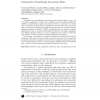Free Online Productivity Tools
i2Speak
i2Symbol
i2OCR
iTex2Img
iWeb2Print
iWeb2Shot
i2Type
iPdf2Split
iPdf2Merge
i2Bopomofo
i2Arabic
i2Style
i2Image
i2PDF
iLatex2Rtf
Sci2ools
DATAMINE
2002
2002
Cubegrades: Generalizing Association Rules
Cubegrades are generalization of association rules which represent how a set of measures (aggregates) is affected by modifying a cube through specialization (rolldown), generalization (rollup) and mutation (which is a change in one of the cube's dimensions). Cubegrades are significantly more expressive than association rules in capturing trends and patterns in data because they can use other standard aggregate measures, in addition to COUNT. Cubegrades are atoms which can support sophisticated "what if" analysis tasks dealing with behavior of arbitrary aggregates over different database segments. As such, cubegrades can be useful in marketing, sales analysis, and other typical data mining applications in business. In this paper we introduce the concept of cubegrades. We define them and give examples of their usage. We then describe in detail an important task for computing cubegrades: generation of significant cubes which is analogous to generating frequent sets. We als...
| Added | 18 Dec 2010 |
| Updated | 18 Dec 2010 |
| Type | Journal |
| Year | 2002 |
| Where | DATAMINE |
| Authors | Tomasz Imielinski, Leonid Khachiyan, Amin Abdulghani |
Comments (0)

